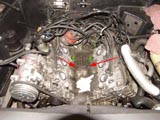|
|
A tale of two engines. . .
Click on the thumbnail for a bigger image. .
 |
The DeLorean's PRV (Peugeot, Renault, Volvo) engine is know as a
hearty and long lasting engine. . .but no car can run forever
without good doses of oil. My car is proof of that.
The PRV engine has some interesting "holes" in the top
of it that were probably used to help make casting easier and / or
to keep the weight of the engine down. The green spots in
the picture are the openings containing antifreeze. These
holes in the block have a tendency to collect all kinds of gunk.
Road dirt, antifreeze, etc. Some of these items have a
desire to eat through metal substances. . .like aluminum. . .See
where I am going yet? (HINT: The engine block is made out of
aluminum) |
 |
Sometime before I got my car (It had 17,500 miles on it when I
got it). one of these holes grew to include the oil reservoir
below it, making a nice oil fountain when the engine was
running. To solve this oil-spouting problem, the hole was
pressure filled with epoxy. Problem solved right? With
no more oil leak, the problem went away. You can see the hole with
the remains of the epoxy in it to the left. |
 |
Sounds like a fairly good solution to me, except for one
thing. Since the epoxy was pressure pumped into the hole,
some of the epoxy (a lot actually) got down into the oil
reservoir. The created a nice clog in the oil line, hence
the failure of my engine. The fix that was applied (epoxy
seal the hole) was probably the least expensive fix. . .(I had
that presented as a re-solution after my engine had to be rebuilt)
but only in the short term. This solution has in the long
run cost me over $6000. I will say it again $6000
The proper solution would have been to replace the
engine block from the get go. Total cost around $1500 with
labor. Not exactly chump change, but a far cry from $6000.
To the left is my brand new (I.E. used) engine block off of a
Volvo. I inspected it personally to ensure that it complied
with the Babb Standard of Automotive Excellence (BSAE). |
 |
After the new engine block is mated with the rest of my cars
engine, we will be looking at options to keep this from happening
in the future. I want to fill these holes in, but without
the possibility of moisture getting between the filler and the
engine block. Any suggestions? HAVE YOUR CAR CHECKED! The cost
of having a qualified mechanic check your engine block could save
you the cost of a new block. (part of the water pump
replacement process will get you down far enough to check things out
as well) These holes are about 5 inches deep,
and can collect a lot of goop. To give you an idea of the
size of these, the picture on the left shows the two pieces of
epoxy extracted from the car. The big piece was pulled out
of the top of the hole, while the bottom piece was inside the oil
reservoir itself. |
|
|
This page last modified on
Tuesday, April 08, 2008
|
|
